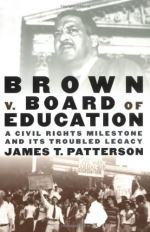|
This section contains 793 words (approx. 2 pages at 400 words per page) |

|
Summary
Thurgood Marshall admitted to reporters that litigation was not the sole answer to racism and discrimination. The lawsuits against segregation in schools were piling up for him and the Fund lawyers. He privately questioned whether Brown had set back the civil rights movement in general. Black activism was steadily arousing some veteran players like Medgar Evers to continue protests. Martin Luther King, Jr., held a prayer vigil on the anniversary of Brown in 1957 although he was less inspired by Brown than he was with Christianity and non-violence. However, Brown did not inspire northern whites who were largely disinterested in integration or in improving the lives of blacks. Southern blacks were uneasy about sending their kids to white schools. The number of public protests against segregation declined after Brown.
Just when Marshall was struggling with the failure of...
(read more from the Chapter 6: Striving for Racial Balance in the 1960s Summary)
|
This section contains 793 words (approx. 2 pages at 400 words per page) |

|




